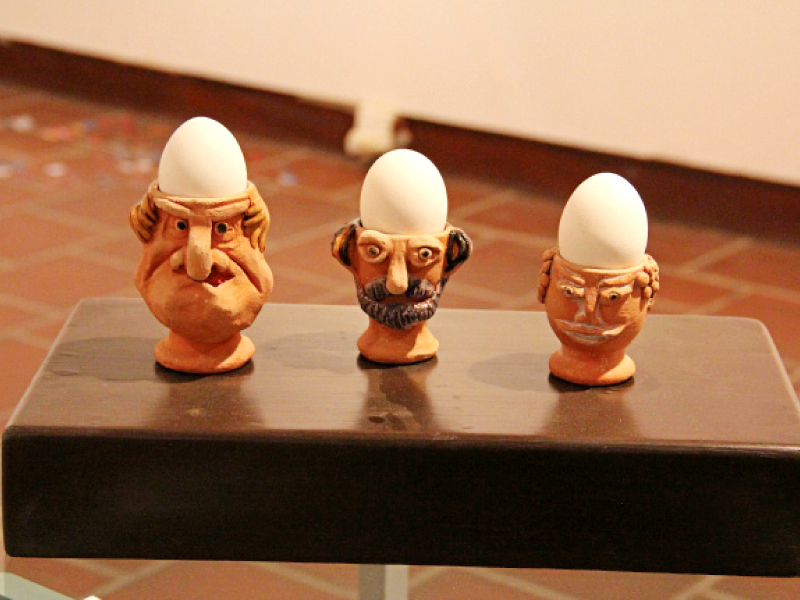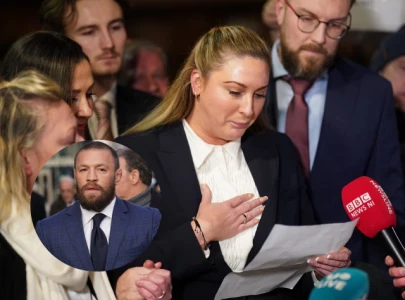
White balloons scattered on the floor, low-hanging lights that one had to dodge to manoeuvre through the bright labyrinth, the Victorian stone brick buildings glowing orange in the night lights - the entrance to the sixth Alumni Show at the Indus Valley School for Art and Architecture (IVS) Gallery was just as beautiful as the art within.
When you climb down the steps to the gallery itself, you are greeted by a large circular piece hanging on the wall, an arrow moving on it in a clockwise direction. The word ‘play’ was written below it - the title of the gallery - and it portrayed the message that the art inside the gallery was not merely to be admired but to be played with.
By allowing the audience to interact with their art, the artists made them part of it - bringing their art to life. Nida Faizi’s Bit by Bit featured painted pieces of tiles that could be arranged by the audience to build different images, each person rearranging the pieces to create their very own picture. Some were distracted half way through and left it unfinished, the remaining pieces stacked in a corner - the broken, incomplete image looking all the more beautiful.
Nazia Anwar and Ahmed Aleem’s Alif se Guitar was hung in a far corner, yet attracted the most interest. The ‘sculpture’ - if it can be called that, for it barely qualified - was a working instrument, a mixture of the electric guitar and the nastaleekh. Connected to an amplifier, it was accompanied by a piece of paper that said ‘feel free to play’ and many obliged. The mixture of the two instruments, one from the West and the other decidedly Eastern, created a unique blend that was as curious as it was pleasing. “Keeping in mind the fusion of music that is often seen in Pakistan today, we decided to fuse instruments together,” said Aleem. “That is where the name Alif se Guitar comes from.”
Beside the instrument was a small jar of chits, sitting on a coffee table. The chits had varying instructions on them, with the audience asked to do what the chit instructed. “I was never good at sports so I was often not picked,” said Sara Jamil, the artist behind the Pick and Play concept. “I wanted to portray that feeling of being left out and that is why I have created this. Most of the chits just say ‘sorry, you have not been picked’.”
On the other side of the gallery, Nagin Ansari’s Karachi Crosswords was a giant crossword that featured some of the most commonly used words in Karachi as well as those that define the city. The idea was for audience members to each find one word and to circle it as they would with a normal crossword. Words such as ‘hope’, ‘courage’, ‘give’ and ‘forgiveness’ intertwined with more sinister ones, such as ‘lethal’ and ‘gunpoint’. A crossword that painted Karachi perfectly - a city with two polar realities, both just as obvious as the other, often being realised and narrated at the same time.
Another popular concept, especially among the female audience members, was Humayun Memon’s #Selfiestop, an ode to the current social media and self-portrait craze that is found in most teenagers. The audience could stand between two painted mirrors and take a picture of themselves, each picture unique due to the differing subjects.
The more you interacted with it, the more you became part of the art, until it seemed unfathomable to enjoy it without the audience - the attraction and the admirer both merging into one, giving a whole new meaning to ‘beauty lies within the beholder’.
The art that remained aloof
Along with the countless interactive art pieces, there were some that were more conventional - to be admired from a distance rather than to be immersed in. Zedol! by Nabahat Lotia stood right in the middle of the gallery. Three small clay egg holder figurines with eggs on them. The pieces were available for Rs10,000 - a bit steep for something that holds chicken eggs but good art is never cheap.
Essa Taimur’s An Ode to Araki is a set of three paintings that pays tribute the great Japanese artist Araki. The subject in all three paintings is wearing a gas mask, giving the otherwise serene scenes an ominous look. The three paintings, displayed together, highlighted their similarities but also flaunted their slight differences. “I like the way the subject in the paintings becomes more subtle in the last painting,” said art enthusiast Abbas Gillani, who stood silently, admiring the paintings.
Published in The Express Tribune, March 15th, 2014.





1732600231-0/BeFunk_§_]__-(50)1732600231-0.jpg)











COMMENTS
Comments are moderated and generally will be posted if they are on-topic and not abusive.
For more information, please see our Comments FAQ